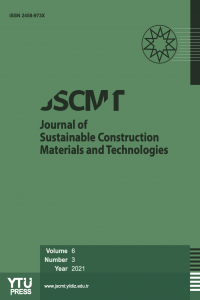Effect of using colemanite and basalt fiber on the mechanical properties of metakaolin-based geopolymer mortars
Effect of using colemanite and basalt fiber on the mechanical properties of metakaolin-based geopolymer mortars
Geopolymer, Metakaolin, Colemanite, Basalt Fibers,
___
- 1. Klein, Manfred and Donald Rose, "Development of CME National Emission Guidelines for Cement Kilns” in CANMET/ACZ International Symposium on Sustainable Development of the Cement and Concrete Industry, editorV.M.Malhotra, Ottawa, October 1998, pp. 16-30.Klein, Manfred and Donald Rose, "Development of CME National Emission Guidelines for Cement Kilns” in CANMET/ACZ International Symposium on Sustainable Development of the Cement and Concrete Industry, editorV.M.Malhotra, Ottawa, October 1998, pp. 16-30.
- 2. D. N. Huntzinger., T. D. Eatmon. A life-cycle assessment of Portland cement manufacturing: comparing the traditional process with alternative technologies. In Journal of Cleaner Production 17 (2009) 668–675.
- 3. M. Stajanča and A. Eštokova. “Environmental Impacts Of Cement Production” University of Košice ,( 2012)
- 4. T. W. Bremner “Environmental Aspects Of Concrete Problems and Solutions” in 1st All-Russian Conference on Concrete and Reinforced Concrete, ( 2001).
- 5. Joseph Davidovits.”Geopolymers: Inorganic Polymeric New Materials”, in Thermal Analysis Journal, Saint Quentin, France, (1991).
- 6. Joseph Davidovits.”Environmentally Driven Geopolymer Cement Application”, in Geopolymer conference, Melbourne, Australia, (2002).
- 7. A. Palmo., M. W. Grutzeck. And M. T. Blanco. “Alkali-activated fly ashes A cement for the future” in Cement and Concrete Research,Spain ,(1999).
- 8. Joseph Davidovits.”Geopolymer Cement”, Institute of Geopolymer, France, (2013).
- 9. A. Palmo., P. Krivenko., I. Garcia-Lodeiro., E. Kavalerova., O. Maltseva and A. Fernandez-Jimenez., “ A review on alkaline activation: new analytical perspectives ” in construction materials journal., Madrid, Spain ,(2014).
- 10. H. Rahier, B. Van Mele and J. Wastiels. Low-temperature synthesized aluminosilicate glasses J.Mater.Sci.31 80-85 (1996).
- 11. Joseph Davidovits. Geopolymer Chemistry and Application, Institute of Geopolymer, Quentin, France – 4th edition (2008)- 393.
- 12. S. Das, and P. Saha.,” Sustainable and Durable Mortar/Concrete Using Geopolymer”. 3rd World conference on Applied Science, Engineering and Technology, Nepal, (2014).
- 13. G. Hemanaag, and B. S. R. K. Prasad.,” Geo-polymer Concrete using Metakaolin, Fly-Ash and their comparision”. International Journal of Engineering Research and Technology., India, (2014).
- 14. S. E. Wallah and B. V. Rangan, "Low –calcium fly ash based geopolymer concrete: long-term properties", Research Report GC2, Faculty of Engineering, Curtin University of Technology, Perth, Australia, 2006, pp. 1-97.
- 15. P. Behera, V. Baheti, J. Militky and P. Louda. “Elevated temperature properties of basalt micofibril filled geopolymer composites”, in Construction and Building Materials, 2018.
- 16. E. Rill, D. R. Lowry, and W. M. Kriven. “Properties of Basalt Fiber Reinforced Geopolymer Composites”, Departement of Material Science and Endineering, University of Illinois at Urban-Champaign, Urbana, USA.
- 17. L. Chen, Z. Wang, Y. Wang and J. Feng. “Prepartion and Properties of Alkali Activated Metakaolin-Based Geopolymer”, in Materials journal , (2016).
- 18. L. Aponte, R. Gutierrrez, and A. Ramirez. “Metakaolin-Based Geopolymer withAdded TiO2 Particles: Physicomechanical Characteristics”,Editor : S. Gross, in Coatings Journal, (2017).
- 19. A. Celik, and G. Cakal. “Characterization of Espey Colemanite and Variation of its Physical Properties with Temperature”, in Physicochemical Problems of Mineral Processing Journal, Ankara, Turkey, (2014).
- 20. ASTM C109/109M, Standard Test Method for Compressive Strength of Hydraulic Cement Mortars, Annual Book of ASTM Standards (Using 2-in. or [50-mm] Cube Specimens, 1. Chemical Analysis, (C109/C109M – 11b), 2010, pp 1-9.
- 21. ASTM C348, Standard Test Method for Flexural Strength of Hydraulic Cement Mortars, Annual Book of ASTM Standards, 1998, pp 2-7.
- Başlangıç: 2016
- Yayıncı: Yıldız Teknik Üniversitesi
Nawar ALİ, Orhan CANPOLAT, Mukhallad M. AL-MASHHADANİ, Yurdakul AYGÖRMEZ, Mucteba UYSAL
Mustafa KARAGÖZ, Orhan CANPOLAT, Mukhallad M. AL-MASHHADANİ, Yurdakul AYGÖRMEZ, Mucteba UYSAL
Investigation of Waste Products of Boron and Metakaolin Utilizes
Mikhail MUSHUROV, Orhan CANPOLAT, Mucteba UYSAL, Mukhallad M. AL-MASHHADANİ, Yurdakul AYGÖRMEZ
Infrastructure Projects In Turkey and Innovative Implementations In Project Management
